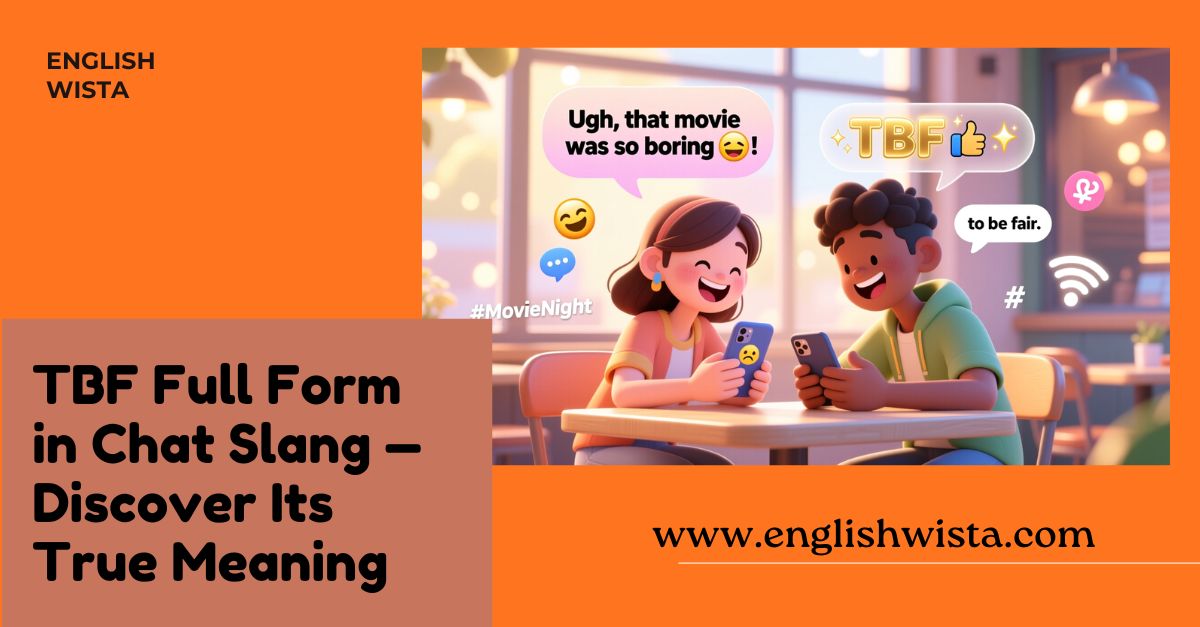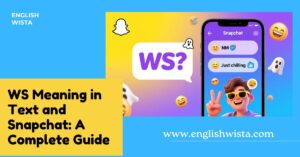If you spend time texting friends, scrolling through social media, or chatting online, you’ve probably come across lots of short forms and abbreviations. From “LOL” to “BRB,” the internet has its own language, and it’s constantly evolving. One abbreviation you might have seen is TBF. At first glance, it looks like just three random letters. But like many other acronyms, these letters carry meaning that makes conversations faster and more expressive.
So, what does TBF stand for in chat? Don’t worry you don’t need to be a texting pro to understand it. In this article, we’ll break it down step by step, explain its meaning, give you real-life examples, share some fun facts, and help you start using it naturally in your own conversations. By the end, you’ll feel confident the next time someone drops a “TBF” in your messages.
Let’s dive in!
What Does TBF Mean?
The full form of TBF in chat is “To Be Fair.”
It’s a phrase people use when they want to balance a conversation, add fairness to a point, or admit something that might go against their own argument. Think of it as a way to soften what you’re saying or to show that you’re considering both sides of a situation.
For example:
- “TBF, he did warn us about being late.”
- “I didn’t like the movie, but TBF, the acting was pretty good.”
So, whenever you see TBF, just read it as “to be fair.”
Why Do People Use TBF in Chats?
Online conversations move fast. Nobody wants to type out long sentences all the time. Abbreviations like TBF save time, keep the flow going, and add personality to texts.
Here are a few reasons why people prefer using TBF:
- It’s quick and easy. Typing three letters is faster than spelling out “to be fair.”
- It makes you sound casual. Abbreviations feel friendly and conversational.
- It helps show balance. When you say “TBF,” you’re acknowledging the other side of the story.
- It’s trendy. Just like other chat slang, using TBF shows you’re familiar with internet culture.
How Do You Use TBF in a Sentence?
Using TBF is simple once you get the hang of it. Most of the time, it comes at the beginning of a sentence, but you can place it in the middle too.
Here are some examples:
- At the start: “TBF, I didn’t expect him to win, but he did a great job.”
- In the middle: “I’m not a fan of this song, but TBF, the beat is pretty catchy.”
- As a quick reply: Friend: “I think that restaurant is overrated.” You: “TBF, their desserts are amazing.”
See how it works? It’s like a little reminder that fairness matters in the conversation.
Common Situations Where TBF Fits Perfectly
Let’s look at some everyday scenarios where TBF can naturally appear:
- When defending someone:
- “TBF, she only made that mistake once.”
- When being honest about your own opinion:
- “I don’t usually like spicy food, but TBF, this curry is delicious.”
- When pointing out the other side of the story:
- “The project was tough, but TBF, we learned a lot from it.”
- When making jokes more balanced:
- “He’s terrible at soccer, but TBF, so am I!”
By practicing in these kinds of situations, you’ll start to feel comfortable using it without even thinking.
Is TBF Formal or Informal?
Here’s something important to remember: TBF is informal.
That means it works perfectly in casual chats, text messages, or social media posts. But it’s not the best choice for professional emails, job applications, or formal documents.
For example:
- Right for chat: “TBF, that movie wasn’t as bad as people said.”
- Wrong for business email: “TBF, I believe the report is accurate.”
So, save TBF for relaxed conversations with friends or peers.
Variations and Similar Expressions
Now you might be wondering are there other ways people say the same thing? Yes! The internet loves variety. Here are some alternatives:
- TBH – “To Be Honest.” Similar vibe, but instead of fairness, it’s about honesty.
- IMO – “In My Opinion.” This shows your personal view.
- IMHO – “In My Humble Opinion.” A softer version of IMO.
- FWIW – “For What It’s Worth.” Another phrase used when trying to balance a point.
So, if you’ve seen TBH and thought it looked familiar, now you know it’s a cousin of TBF.
Real-Life Examples of TBF in Chats
Let’s imagine some short conversations where TBF pops up naturally:
Example 1 – Talking about sports:
- Friend 1: “Our team is terrible this season.”
- Friend 2: “TBF, we did beat the top-ranked team last week.”
In Example 2 – Talking about school:
- Friend 1: “That exam was impossible.”
- Friend 2: “TBF, the teacher did give us a study guide.”
Example 3 – Talking about movies:
- Friend 1: “I hated the plot.”
- Friend 2: “Yeah, but TBF, the visuals were amazing.”
Example 4 – Talking about friends:
- Friend 1: “He never texts back.”
- Friend 2: “TBF, he’s been really busy with work.”
These examples show that TBF isn’t about agreeing or disagreeing it’s about making the conversation more balanced.
Fun Facts About TBF
Here are some interesting little extras about TBF:
- It’s been around for years. While some slang comes and goes quickly, TBF has been used online for a long time and is still popular.
- It’s not just online. Some people even say “TBF” out loud in real life! Instead of saying “to be fair,” they’ll just use the letters.
- It works in memes. Memes and funny posts often include “TBF” to add humor while still sounding casual.
- Different cultures, same meaning. While the phrase “to be fair” is English, similar ideas exist in other languages like saying “honestly” or “in fairness.”
Misconceptions About TBF
Sometimes people confuse TBF with other abbreviations. Let’s clear up a few common mix-ups:
- Not “Throwback Friday.” Some might guess TBF is similar to “TBT” (Throwback Thursday), but that’s not correct.
- Not about finance. In professional settings, TBF can mean “Total Bond Fund” or something technical, but in casual chats it always means “To Be Fair.”
- Not rude. Unlike some slang, TBF is neutral it doesn’t come across as offensive or harsh.
So if you’re worried about sounding rude, don’t be. TBF is safe to use.
Tips for Using TBF Naturally
If you’re new to internet slang, using abbreviations like TBF might feel awkward at first. Here are a few simple tips to make it feel natural:
- Start small. Use it once in a casual chat and see how it feels.
- Follow your friends. If your friends use TBF, mirror their style.
- Don’t overuse it. Like all slang, it’s best in moderation.
- Pair it with humor. TBF often works well in funny or lighthearted conversations.
Quick Recap of Key Points
- TBF stands for “To Be Fair.”
- It’s used to show balance, fairness, or the other side of a situation.
- Best for casual chats, texts, and social media.
- Not ideal for formal or professional communication.
- Works well at the start of a sentence or as a quick reply.
- Similar phrases: TBH, IMO, IMHO, FWIW.
- Fun, simple, and easy to use in everyday conversations.
Conclusion
Language on the internet is always changing, and abbreviations like TBF make chatting faster, friendlier, and a little more fun. Now you know that TBF means “to be fair,” you can spot it in texts and even use it yourself.
The next time your friend complains about something, you can balance the conversation by saying, “TBF, it wasn’t that bad.” Or when you’re admitting a fair point, you can drop a quick “TBF” at the start of your sentence.
So, TBF, learning internet slang isn’t hard it’s just about knowing a few shortcuts. And now that you’ve got this one mastered, you’re one step closer to speaking the internet’s language like a pro.



